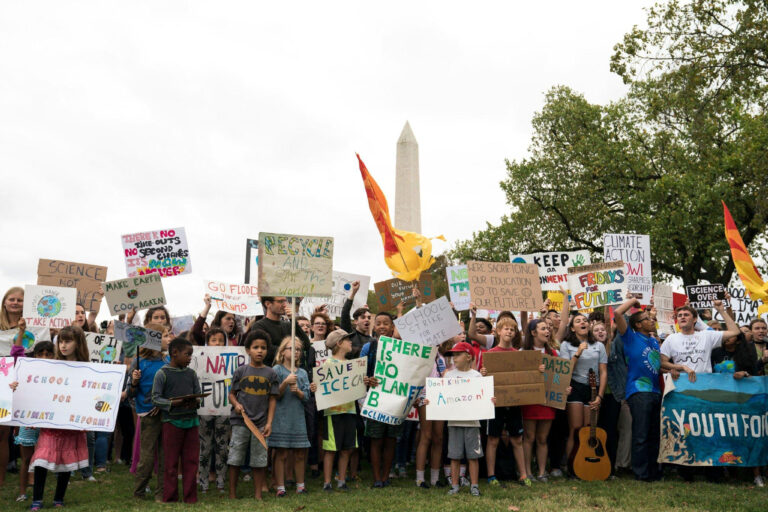Young climate activists witness the world they stand to inherit, lurching toward catastrophe as the climate unravels. Their homeland grows haunted by raging wildfires, battered coasts, and extreme storms. Impatient with the crawl of political motion, those feeling most betrayed take up the mantle – appeals for their right to a living future amplifying from embassy sit-ins to massive marches. They bring legal challenges against governments failing to safeguard their survival. Economic threats may compel politicians, but the moral awakening comes from youth wielding their power for all generations. A livable tomorrow must come.
. Their homeland grows haunted by raging wildfires, battered coasts, and extreme storms. Impatient with the crawl of political motion, those feeling most betrayed take up the mantle – appeals for their right to a living future amplifying from embassy sit-ins to massive marches. They bring legal challenges against governments failing to safeguard their survival. Economic threats may compel politicians, but the moral awakening comes from youth wielding their power for all generations. A livable tomorrow must come.
Origins of the Modern Young Climate Activists
The current era of youth climate activism exploded following the 2018 school strike for climate launched by Swedish student Greta Thunberg. Then, at just 15 years old, Thunberg began spending her school days protesting outside Sweden’s parliament, calling for stronger climate policies and carbon emissions cuts. Her small protest soon sparked a wave of school strikes across Europe under the banner Fridays for Future.
Greta Thunberg Sparks a Global Movement
Inspired by Thunberg’s stand, an estimated 1.6 million students across 125 countries participated in the first coordinated global school strike for climate on March 15, 2019. Organizers like Alexandria Villaseñor soon launched weekly Fridays for Future strikes in the United States. At the same time, young activists from Thailand to Colombia staged their protests around a common goal of demanding climate action.
In September 2019, Thunberg and other young climate activists organized the single largest climate demonstration in history, with over 6 million citizens across 185 countries marching during Climate Week. Galvanized by young voices, global public concern over climate change has reached record levels, putting pressure on governments to make meaningful policy changes.
Diverse Youth Networks Mobilize
Far from being limited to school strikes, youth climate activism encompasses an incredibly diverse array of groups, networks, and movements – from the Sunrise Movement to Zero Hour to regional hubs like Youth v Gov taking governments to court. Indigenous groups like the International Indigenous Youth Council (IIYC) bring unique cultural worldviews on humanity’s relationship with nature.
These collectives are united by a shared sense of urgency and willingness to push beyond traditional environmentalist tactics to demand systemic change. Many activists argue incremental policy changes are not enough, calling for a Green New Deal level of ambitious climate action.

Pushing Businesses to Up Their Climate Commitments
On top of lobbying governments, young climate activists press corporations to strengthen their climate commitments through boycotts, protests, and online campaigns.
Social Media Activism and Greenwashing Calls-Outs
Using digital tools, young people can rapidly coordinate action and call out cases of corporate or political “greenwashing.” Online collective actions have targeted major brands like Coca-Cola to drop their plastics lobbying, HSBC over its climate record, and clothing retailers for fast fashion waste.
Hashtag campaigns like #FridaysForFuture and #SchoolStrike4Climate help amplify protest images and messages across the web for maximum impact. When businesses or politicians make new climate pledges, youth activists will quickly analyze if they align with the latest climate science recommendations and keep up the public pressure regardless.
Boycotts and Strikes for Climate Accountability
Activists argue many corporate sustainability plans with 2050 net-zero targets need more urgency and allow continued environmental harm in the interim. Groups, like Make Amazon Pay, have launched Black Friday boycotts and strikes at Amazon warehouses to protest the tech giant’s climate footprint and labor practices.
Similarly, September 2020 saw young climate activists organize a wide-reaching Global Day of Climate Action during the COVID pandemic, involving over 6,700 actions across 148 countries. Both online and socially distanced outdoor protests kept the public focused on looming climate deadlines while also responding to intersecting racial and economic justice issues.
Changing What’s Politically Possible
While concrete policy achievements emerging directly from youth climate protests have been limited, activists argue their core purpose is to push the boundaries of political possibility.
Young climate leaders believe they are widening the Overton Window of climate policy options under consideration by vocally and unapologetically demanding bold proposals like the Green New Deal. In parallel, climate organizers work hard to register and turn out young voters most impacted by climate change.
Combined with urgent moral appeals, this “outside” activist pressure complements the work of environmental groups negotiating change more quietly “inside” the halls of power. It will likely take the combination of noisy public mobilizing and closed-door policy crafting to drive through robust climate action at the required speed and scale.
A Decisive Decade for Climate Action
The coming decade will determine whether civilization can curb emissions in time to prevent the worst-case climate scenarios. As deadlines and dire scientific warnings draw closer, young climate activists show no signs of putting pressure on governments and corporations failing to safeguard their right to a liveable future.
Youth activists believe that having to bear the long-term consequences of climate inaction more than any other demographic gives them a unique moral authority to demand immediate changes. They are clarifying that business and politics will not be tolerated as usual.
The wave of youth climate protests that exploded onto the global stage in 2018 has fundamentally shifted what is politically feasible. Expect young climate activists to continue ratcheting creative, non-violent resistance until their voices can no longer be ignored.
How did the modern youth climate movement start?
The current era began when Swedish student Greta Thunberg, then 15, started protesting outside Sweden’s parliament in 2018, spurring youth strikes across Europe. Her stand inspired over 1.6 million students in 125 countries to participate in the first coordinated global strike in March 2019.
What do young climate activists want?
They demand urgent climate action from governments and corporations. While specific demands vary, most call for ambitious emissions cuts, renewable energy transitions, and climate policies like the Green New Deal. They push climate commitments aligned with the latest science.
What tactics do young climate activists use?
Tactics include mass protests, school strikes, social media campaigns, lawsuits against governments, boycotts targeting corporations, and voter registration drives. They aim to shift what is politically feasible and see activist pressure as complementing policy negotiations.
Why do youth have unique moral authority on climate?
Youth will live the long-term impacts of climate inaction more than any generation, so argue they have the greatest moral authority to demand a livable future. Having to bear climate consequences gives them power to clarify business and politics as usual cannot continue.
Will youth climate activism continue growing?
With deadlines drawing closer, youth show no signs of easing pressure on institutions failing to safeguard their right to a liveable tomorrow. Expect creative resistance to ratchet up until politicians can no longer ignore these voices.
